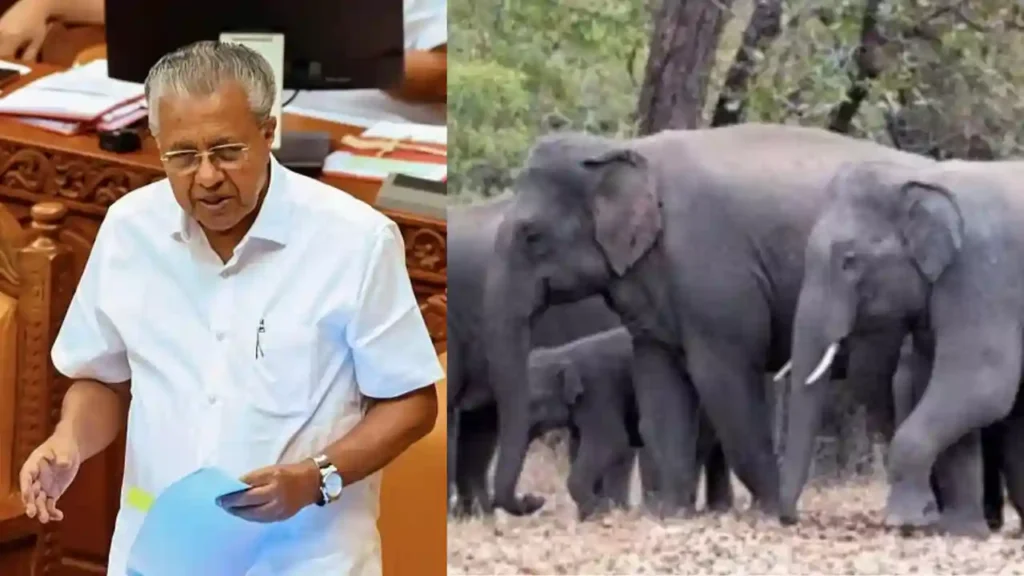New Delhi: In a groundbreaking development that’s set to reshape wildlife management in India, the Kerala Cabinet has greenlit a draft amendment bill targeting the Wildlife Protection Act (WPA) of 1972. This legislative push, unveiled on September 13, 2025, directly addresses the escalating tensions between humans and wildlife in one of India’s most biodiverse states. Dubbed the Wildlife Protection (Amendment) Bill, 2025, it proposes streamlined protocols for neutralizing wild animals that venture into human settlements and launch attacks, marking the inaugural instance of a state government daring to tweak a central statute on such grounds.
As Kerala’s lush forests butt up against burgeoning urban fringes, stories of tragic encounters—elephants trampling farmers, wild boars ravaging crops, and monkeys raiding homes—have become alarmingly routine. This bill isn’t just policy tinkering; it’s a clarion call for balancing ecological preservation with the right to life in conflict zones. With the state assembly session kicking off on September 15, 2025, the draft is primed for heated debates, potentially influencing national discourse on human-wildlife coexistence.

Unpacking the Core Provisions: From Permits to Immediate Action
At the heart of this amendment lies a radical shift in authority. Under the existing WPA framework, the Chief Wildlife Warden (CWW) holds the power to issue permits for the hunting of animals listed across Schedules I, II, III, or IV—but only if they pose an imminent danger to human lives. This process, often mired in red tape, demands exhaustive documentation, including proofs that capture, tranquilization, or relocation aren’t viable options. Moreover, any captured creature must avoid harm or prolonged captivity, with lethal measures reserved strictly as a final recourse, especially for Schedule I species like tigers and elephants that receive the highest safeguards.
The new bill flips this script. It vests the CWW with unilateral authority to mandate the immediate elimination of any wild animal that infiltrates residential zones and inflicts injuries on people. Imagine a scenario: a wild boar charges through a village backyard, goring a resident. No longer will officials twiddle thumbs awaiting layers of approvals. Instead, upon notification of serious harm—relayed swiftly by the district collector or chief forest conservator—the CWW can greenlight culling on the spot, bypassing the “cumbersome and time-consuming procedures” enshrined in the central law and Union-issued Standard Operating Procedures (SOPs).
This isn’t blanket permission for a free-for-all hunt. The measure carves out a narrow but critical pathway for emergencies, ensuring that broader conservation goals remain intact. Forest Minister A K Saseendran underscored this nuance during a press briefing, stating, “This will enable swift action in emergencies without compromising efforts to protect endangered species.” His words echo a frustration shared by frontline foresters: the current system’s “impractical legal barriers” have, in the past, paralyzed responses to real-time threats.
Vermin Declaration: Handing States the Reins on Population Control
One of the bill’s most contentious clauses empowers the Kerala government to unilaterally classify any wild animal from Schedule II—think wild boars, civets, or certain monkey species—as “vermin.” Presently, Section 62 of the WPA reserves this prerogative for the central government, which can only tag animals outside Schedule I or Part II of Schedule II as vermin, slotting them into Schedule V. Such a designation opens the floodgates for legalized culling within designated zones for a finite duration, often to curb overpopulation or mitigate crop destruction.
Kerala’s repeated pleas to the Centre for vermin status on wild boars—a notorious crop-raider—have fallen on deaf ears, fueling local exasperation. By wresting this power, the state sidesteps Delhi’s veto, allowing for targeted interventions like birth control, translocation, or outright elimination when populations spiral out of control. Vermin-tagged animals could then be dispatched “by any means,” with zero curbs on utilizing their remains, including meat consumption—a pragmatic nod to rural economies where such resources might otherwise go to waste.
Adding another layer, the draft floats shifting monkeys, specifically the bonnet macaque, from the ultra-protected Schedule I to the less stringent Schedule II. Schedule I’s elite status demands near-impossible hurdles before any intervention, while Schedule II offers more flexibility for management. This reclassification could prove pivotal in monkey-prone areas, where troops of these agile primates have turned villages into chaos zones.
In parallel, the bill mandates that local government body chairpersons step up as honorary wildlife wardens, bolstering grassroots enforcement. No longer beholden to Union nods for these measures, Kerala aims to forge a more autonomous path, one that resonates with on-ground realities rather than bureaucratic abstractions.
The Perfect Storm: Why Human-Wildlife Clashes Are Exploding in Kerala
Kerala’s emerald landscapes, once a harmonious blend of wilderness and human ingenuity, now simmer with discord. The surge in conflicts isn’t random; it’s a toxic brew of anthropogenic pressures. Foremost is habitat fragmentation: breakneck urbanization, rampant deforestation, and encroachments have severed vital animal corridors, forcing species like elephants and leopards into unnatural proximity with communities. What was once a forested buffer now stands as concrete sprawl.
Compounding this is fierce resource rivalry. As forests shrink, so do supplies of forage and water, driving desperate animals toward villages in search of sustenance. Climate change fans the flames, unleashing erratic monsoons and heatwaves that scramble migration routes, herding wildlife into uncharted territories. A single altered weather pattern can propel a herd of elephants off-course, straight into a tea estate.
Lurking beneath is the shadowy scourge of poaching and illicit wildlife trade, which unravels ecosystems and displaces survivors. Trophy hunters and black-market dealers don’t just thin herds; they destabilize balances, pushing remnant populations into human crosshairs. Official tallies paint a grim picture: between 2016 and 2023, Kerala logged a staggering 55,839 wildlife attack incidents, culminating in 909 fatalities by early 2024. Of these, 180 souls were lost to elephant rampages alone—a stark testament to the stakes.
High-range districts like Wayanad and Idukki, cradles of Kerala’s biodiversity, have erupted in protests. Farmers, their fields decimated by boar tusks and elephant trunks, demand recourse. These cries have pierced the political bubble, especially with local body polls looming in late 2025 and assembly elections in 2026. Critics whisper of vote-bank calculus, but proponents counter that inaction is the real electoral poison.
Echoes from the Past: The Avni Saga as a Cautionary Tale
To grasp the bill’s urgency, rewind to 2018 Maharashtra, where the tigress Avni became a symbol of systemic paralysis. Dubbed a man-eater after allegedly claiming 13 lives, Avni prompted a shoot-on-sight directive from the local CWW. Yet, the Nagpur Bench of the Bombay High Court intervened, insisting on ironclad evidence of her cannibalistic habits. Legal wrangling dragged on, ensnaring officials in a web of affidavits and appeals, even as villagers lived in terror. Avni’s fate—shot dead amid controversy—highlighted how WPA’s safeguards, while noble, can morph into shackles during crises.
Minister Saseendran invoked this episode pointedly: “The case of the female tigress ‘Avni’ remains a prominent example of the challenges posed by these rules.” Kerala’s draft, he argued, dismantles such “impractical key provisions,” freeing wardens to act decisively. Section 11(1)(a) of the central act, which insists on written justifications for forgoing non-lethal options, gets a pragmatic overhaul here—prioritizing lives over paperwork when seconds count.
Beyond Wildlife: Companion Reforms in Forestry and Housing
The Cabinet’s September 13 meeting wasn’t a solo act. Alongside the wildlife amendment, it endorsed the draft Kerala Forest (Amendment) Bill, 2025, a boon for private landowners harboring sandalwood trees. Long hemmed in by regulations, owners can now harvest and vend these aromatic giants through official Forest Department outlets, injecting vitality into rural livelihoods without flouting sustainability norms.
Rounding out the trio is a housing safeguard bill, shielding vulnerable families from eviction over loan defaults on their sole residences. This trinity of drafts—wildlife, forestry, and housing—signals a holistic governance pivot, tackling intertwined woes of ecology, economy, and equity. All are slated for tabling in the assembly from September 15, promising a session crackling with oratory and opposition fire.
Implications for India’s Conservation Landscape: A Federal Flashpoint?
Kerala’s gambit could ripple nationwide. As the first state to amend a Union wildlife law, it tests federalism’s fault lines—can subnational units override central edicts on shared domains? Environmentalists hail the culling clause as a humane hedge against knee-jerk vigilantism, yet warn of slippery slopes toward overkill. “Endangered species would continue to remain protected,” Saseendran assured, but skeptics eye the vermin loophole warily.
Data underscores the imperative: Kerala’s 909 conflict deaths dwarf many peers, underscoring a crisis begging innovation. By empowering local actors—from CWWs to panchayat heads—the bill fosters a decentralized model, potentially exportable to Assam’s rhino belts or Uttarakhand’s leopard lairs.
As the assembly convenes, eyes will lock on Thiruvananthapuram. Will this bill pass muster, or fracture along party lines? For now, in Kerala’s verdant heartlands, one thing rings clear: the wild’s whisper has turned to a roar, and the state is finally tuning in.
FAQs
1. What is the main purpose of the Wildlife Protection (Amendment) Bill, 2025 approved by the Kerala Cabinet?
This draft bill seeks to simplify emergency responses to human-wildlife conflicts by allowing the Chief Wildlife Warden (CWW) to immediately order the culling of any wild animal that enters residential areas and attacks or injures people. It amends the central Wildlife Protection Act (WPA) of 1972 to cut through bureaucratic delays, marking the first such state-level push in India. The goal is to protect human lives in conflict-prone zones like Wayanad and Idukki, while maintaining safeguards for endangered species.
2. How does the bill change the process for dealing with dangerous wild animals under the current WPA?
Under the existing WPA, the CWW can only issue hunting permits for animals in Schedules I-IV after proving non-lethal options (like capture or relocation) are impossible, with detailed written justifications required. Schedule I species (e.g., tigers, elephants) get the strictest protections. The new bill empowers the CWW to act swiftly upon reports from district collectors or chief forest conservators, bypassing Union approvals and time-consuming SOPs. It also allows population controls like translocation or birth regulation for Schedule II animals without central permission.
3. Can Kerala now declare wild animals as ‘vermin’ on its own, and what does that mean?
Yes, the bill grants the state government authority to label any Schedule II animal (e.g., wild boars, civets) as vermin, a power previously exclusive to the central government under Section 62 of the WPA. Once declared vermin and added to Schedule V, these animals can be legally culled in specified areas for a limited time using any method, with no restrictions on using their meat or remains. This addresses Kerala’s failed bids to vermin-tag wild boars, which frequently destroy crops.
4. Why are human-animal conflicts rising in Kerala, and what statistics highlight the issue?
Conflicts stem from habitat loss due to urbanization and deforestation, resource scarcity for food and water, climate-driven migration shifts, and ecosystem disruptions from poaching. From 2016 to 2023, Kerala recorded 55,839 attack incidents, resulting in 909 deaths by early 2024—including 180 from elephants. High-range areas see frequent protests over crop raids by boars and attacks by elephants or leopards, intensified by blocked animal corridors.
5. What other bills were approved alongside this one, and when will they be debated?
The Cabinet also cleared the Kerala Forest (Amendment) Bill, 2025, enabling private landowners to sell sandalwood from their properties via Forest Department outlets, and a housing protection bill to prevent evictions from sole residences due to loan defaults. All three drafts, including the wildlife amendment, are set for introduction and debate in the Kerala Assembly session starting September 15, 2025, amid upcoming local elections and 2026 polls.

